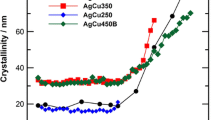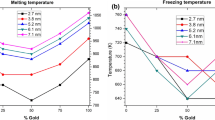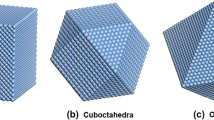Abstract
Binary nanoparticles of an alloy of copper and silver are of great practical interest due to the possibility of fine tuning the plasmonic effects present in them by changing the composition, size, shape, and structure of the nanoparticles. In the present work, the processes of formation of the internal structure of Ag–Cu nanoparticles depending on their target chemical composition, size and intensity of thermal exposure were studied by computer simulation. For this, the computer simulation of the process of crystallization of Ag–Cu nanoparticles with a diameter of 2.0–8.0 nm with an atomic copper content ranging from 10 to 50% was performed using the molecular dynamics method based on the tight-binding potential. To imitate the removal of thermal energy from nanoparticles, an Andersen thermostat was used with three different rates corresponding to cooling times of 0.5, 1.5, and 2.5 ns. Based on the results of the analysis of the available experimental data and the results of the computer simulation, it was concluded that it is possible to control the internal structure and shape of Ag–Cu nanoparticles in order to shift the plasmon resonance peak and enhance it.




Similar content being viewed by others
Data Availability
The work was supported by grants from the Russian Science Foundation, project numbers 23-12-20003, https://rscf.ru/project/23-12-20003/) with parity financial support from the Government of the Republic of Khakassia.
References
Ferrando R, Fortunelli A, Rossi G (2005) Quantum effects on the structure of pure and binary metallic nanoclusters. Phys Rev B 72:085449. https://doi.org/10.1103/PhysRevB.72.085449
Lia Zh, Yanga X, Liua Ch, Wanga J, Li G (2016) Effects of doping in 25-atom bimetallic nanocluster catalysts for carbon–carbon coupling reaction of iodoanisole and phenylacetylene. Prog Nat Sci: Mater Int 26:477–482. https://doi.org/10.1016/j.pnsc.2016.09.007
Bochicchio D, Ferrando R, Panizon E and Rossi G (2016) Structures and segregation patterns of Ag-Cu and Ag-Ni nanoalloys adsorbed on MgO(001). J Phys: Condens Matter 28:064005. https://doi.org/10.1088/0953-8984/28/6/064005
Misirli GM, Sridharan K, Abrantes ShMP (2021) A review on nanostructured silver as a basic ingredient in medicine: physicochemical parameters and characterization. Beilstein J Nanotechnol 12:440–461. https://doi.org/10.3762/bjnano.12.36
Adibkia Kh, Ehsani A, Jodaei A, Fathi E, Farahzadi R, Barzegar-Jalali M (2021) Silver nanoparticles induce the cardiomyogenic differentiation of bone marrow derived mesenchymal stem cells via telomere length extension. Beilstein J Nanotechnol 12:786–797. https://doi.org/10.3762/bjnano.12.62
Matos YB, Romanus RS, Torquato M, de Souza EH, Villanova RL, Soares M, Viana ER (2021) Silver nanoparticles nucleated in NaOH-treated halloysite: a potential antimicrobial material. Beilstein J Nanotechnol 12:798–807. https://doi.org/10.3762/bjnano.12.63
Pem B, Ćurlin M, Jurašin DD, Vrček V, Barbir R, Micek V, Fratila RM, de la Fuente JM, Vrček IV (2021) Fate and transformation of silver nanoparticles in different biological conditions. Beilstein J Nanotechnol 12:665–679. https://doi.org/10.3762/bjnano.12.53
Shin K, Kim DH, Yeo SC, Lee HM (2012) Structural stability of agcu bimetallic nanoparticles and their application as a catalyst: a dft study. Catal Today 185:94–98. https://doi.org/10.1016/j.cattod.2011.09.022
Kim SJ, Stach EA, Handwerker CA (2010) Fabrication of conductive interconnects by ag migration in Cu–Ag coreshell nanoparticles. Appl Phys Lett 96:144101. https://doi.org/10.1063/1.3364132
Panizon E, Bochicchio D, Rossi G, Ferrando R (2014) Tuning the structure of nanoparticles by small concentrations of impurities. Chem Mater 26:3354. https://doi.org/10.1021/cm501001f
Shellaiah M, Sun KW (2017) Luminescent metal nanoclusters for potential chemosensor applications. Chemosensors 5:36. https://doi.org/10.3390/chemosensors5040036
Dubkov SV, Savitskiy AI, Yu TA, Yeritsyan GS, Shaman YuP, Kitsyuk EP, Tarasov A, Shtyka O, Ciesielski R, Gromov DG (2020) SERS in red spectrum region through array of Ag–Cu composite nanoparticles formed by vacuum-thermal evaporation. Optical Materials: X 7:100055. https://doi.org/10.1016/j.omx.2020.100055
Araujo TP, Quiroz J, Barbosa ECM, Camargo PHC (2019) Understanding plasmonic catalysis with controlled nanomaterials based on catalytic and plasmonic metals. Curr Opin Colloid Interface Sci 39:10–122. https://doi.org/10.1016/j.cocis.2019.01.014
Otto A (1984) Surface-enhanced Raman scattering: “classical” and “chemical” origins. In: Cardona M, Güntherodt G (eds) Light scattering in solids IV. Springer Berlin Heidelberg, Berlin, Heidelberg, pp 289–418. http://link.springer.com/10.1007/3–540–11942–6_24. Accessed 20 Oct 2011
Saidi MSAM, Ghoshal SK, Hamzah K, Arifin R, Omar MF, Roslan MK, Sazali ES (2018) Visible light emission from Dy3þ doped tellurite glass: role of silver and titania nanoparticles co-embedment. J Non-Cryst Solids 502:198–209. https://doi.org/10.1016/j.jnoncrysol.2018.09.012
Maurya SK, Tiwari SP, Kumar A, Kumar K (2018) Plasmonic enhancement of upconversion emission in Ag@NaYF4:Er3þ/Yb3þ phosphor. J Rare Earths 36:903–910. https://doi.org/10.1016/j.jre.2018.03.003
Qian K, Sweeny BC, Johnston-Peck AC, Niu W, Graham JO, Chene JSD, Qiu J, Wang Y-C, Engelhard MH, Su D, Stach EA, Wei WD (2014) Surface plasmon-driven water reduction: gold nanoparticle size matters. J Am Chem Soc 136:9842–9845. https://doi.org/10.1021/ja504097v
da Silva AGM, Rodrigues TS, Wang J, Yamada LK, Alves TV, Ornellas FR, Ando RA, Camargo PHC (2015) The fault in their shapes: investigating the surface-plasmon-resonance-mediated catalytic activities of silver quasi-spheres, cubes, triangular prisms, and wires. Langmuir 31:10272–10278. https://doi.org/10.1021/acs.langmuir.5b02838
Gromov DG, Dubkov SV, Savitskiy AI, Shaman YP, Polokhin AA, Belogorokhov IA, Trifonov AY (2019) Optimization of nanostructures based on Au, Ag, Au-Ag nanoparticles formed by thermal evaporation in vacuum for SERS applications. Appl Surf Sci 489:701–707. https://doi.org/10.1016/j.apsusc.2019.05.286
Bharati MSS, Chandu B, Rao SV (2019) Explosives sensing using Ag–Cu alloy nanoparticles synthesized by femtosecond laser ablation and irradiation. RSC Adv 9:1517–1525. https://doi.org/10.1039/C8RA08462A
Tan K S, Cheong K Y (2013) Advances of Ag, Cu, and Ag-Cu alloy nanoparticles synthesized via chemical reduction route. J Nanoparticle Res 15:1537. https://doi.org/10.1007/s11051-013-1537-1
Malviya KD, Chattopadhyay K (2014) Synthesis and mechanism of composition and size dependent morphology selection in nanoparticles of Ag-Cu alloys processed by laser ablation under liquid medium. J Phys Chem C 118:13228–13237. https://doi.org/10.1021/jp502327c
Gromov DG, Pavlova LM, Savitskii AI, Trifonov AY (2015) Investigation of the early stages of condensation of Ag and Au on the amorphous carbon surface during thermal evaporation under vacuum. Phys Solid State 57:173–180. https://doi.org/10.1134/S1063783415010126
Gromov DG, Pavlova LM, Savitsky AI, Trifonov AY (2015) Nucleation and growth of Ag nanoparticles on amorphous carbon surface from vapor phase formed by vacuum evaporation. Appl Phys A 118:1297–1303. https://doi.org/10.1007/s00339-014-8834-0
Rapallo A, Rossi G, Ferrando R, Fortunelli A, Curley BC, Lloyd LD, Johnston RL (2005) Global optimization of bimetallic cluster structures. I. Size-mismatched Ag-Cu, Ag-Ni, and Au-Cu systems. J Chem Phys 122(19):194308. https://doi.org/10.1063/1.1898223
Zhang P, Li Y, Wang D, Xia H (2016) High-yield production of uniform gold nanoparticles with sizes from 31 to 577 nm via one-pot seeded growth and size-dependent SERS property. Part Part Syst Charact 33:924–932. https://doi.org/10.1002/ppsc.201600188
Gromov DG, Dubkov SV, Savitskiy AI, Shaman YuP, Polokhin AA, Belogorokhov IA, Yu TA (2019) Optimization of nanostructures based on Au, Ag, Au-Ag nanoparticles formed by thermal evaporation in vacuum for SERS applications. Appl Surf Sci 489:701–707. https://doi.org/10.1016/j.apsusc.2019.05.286
Abajo FJ (2007) Colloquium: light scattering by particle and hole arrays. Rev Mod Phys 79:1267–1290. https://doi.org/10.1103/RevModPhys.79.1267
Rycenga M, Cobley CM, Zeng J, Li W, Moran ChH, Zhang Q, Qin D, Xia Y (2011) Controlling the synthesis and assembly of silver nanostructures for plasmonic applications. Chem Rev 111:3669–3712. https://doi.org/10.1021/cr100275d
Gafner YY, Gafner SL, Ryzkova DA, Nomoev AV (2021) The role of gold atom concentration in the processes of formation of Cu-Au nanoparticles from the gas phase. Beilstein J Nanotechnol 12:72–81. https://doi.org/10.3762/bjnano.12.6
Gafner SL, Gafner YY (2008) Analysis of gas-phase condensation of nickel nanoparticles. J Exp Theor Phys 107:712–722
Chepkasov IV, Gafner YY, Gafner SL (2016) Changing of the shape and structure of Cu nanoclusters generated from a gas phase: MD simulations. J Aerosol Sci 91:33–42. https://doi.org/10.1016/j.jaerosci.2015.09.004
Gafner Y, Gafner S, Redel L, Zamulin I (2018) Dual structural transition in small nanoparticles of Cu-Au alloy. J Nanopart Res 20:51. https://doi.org/10.1007/s11051-018-4161-2
Nelli D, Ferrando R (2019) Core-shell vs. multi-shell formation in nanoalloy evolution from disordered configurations. Nanoscale 11:13040–13050. https://doi.org/10.1039/C9NR02963J
Nelli D, Koraychy EYE, Cerbelaud M, Crespin B, Videcoq A, Giacomello A, Ferrando R (2023) Two-steps versus one-step solidification pathways of binary metallic nanodroplets. ACS Nano 17:587–596. https://doi.org/10.1021/acsnano.2c09741
Rapetti D, Roncaglia C, Ferrando R (2023) Optimizing the shape and chemical ordering of nanoalloys with specialized walkers. Adv Theory Simul 6:2300268. https://doi.org/10.1002/adts.202300268
Funding
The study was funded by the Russian Science Foundation (project No. 23–12-20003, https://rscf.ru/project/23-12-20003/) with parity financial support from the Government of the Republic of Khakassia.
Author information
Authors and Affiliations
Corresponding author
Ethics declarations
Conflict of Interest
The authors declare that they have no conflict of interest.
Competing Interests
The authors declare no competing interests.
Additional information
Publisher's Note
Springer Nature remains neutral with regard to jurisdictional claims in published maps and institutional affiliations.
Rights and permissions
Springer Nature or its licensor (e.g. a society or other partner) holds exclusive rights to this article under a publishing agreement with the author(s) or other rightsholder(s); author self-archiving of the accepted manuscript version of this article is solely governed by the terms of such publishing agreement and applicable law.
About this article
Cite this article
Gafner, Y., Gafner, S., Redel, L. et al. Estimation of the structure of binary Ag–Cu nanoparticles during their crystallization by computer simulation. J Nanopart Res 25, 205 (2023). https://doi.org/10.1007/s11051-023-05850-y
Received:
Accepted:
Published:
DOI: https://doi.org/10.1007/s11051-023-05850-y




